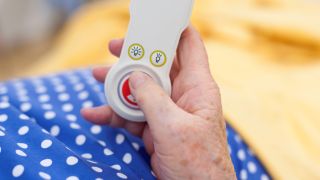How to age in place successfully: 10 steps to start
Planning to age in place gracefully? Consider these top ten factors first to get you ready for the transition.

What does it mean to age-in-place and why is it so important?
The majority of senior citizens are making the conscious decision to grow old in the comfort of their own home, or age-in-place (AIP). Perhaps you're one of them, and that's what brought you here, or maybe you're a concerned family member.
Seniors who age-in-place have the luxury of independence and the contentment that only their home can provide. The question almost always arises, however, whether the senior will be safe without around-the-clock care at their fingertips.
When stairs become difficult to climb and falling becomes more than an inconvenience, it is imperative to add in additional domestic and mobile safety features, such as a medical alert system that provides a lifeline to help in an emergency.
Making sure the added costs such as in-home care, meal delivery, and access to socialization should be reviewed before making the decision. A zero-entry shower, and luxury age in place home design can provide added comfort and address common inconveniences that arise with aging.
And, having family nearby makes that transition to the next phase of life a much more feasible possibility.
At the end of the day, the most important thing to do is plan ahead. When the time comes to make the decision whether or not aging-in-place is the right decision for the aging senior in your life, families can be prepared.
Are you a pro? Subscribe to our newsletter
Sign up to the TechRadar Pro newsletter to get all the top news, opinion, features and guidance your business needs to succeed!
1. Make sure that ageing-in-place is right for you
Of the 28.5 million households with an older adult, more than one-quarter (28%) reported difficulty using some aspect of the home, according to a U.S. Census Bureau report.
USAToday.com
It isn’t an easy decision. Trying to determine whether or not ageing-in-place is right for your loved one or if additional care is needed is tricky and requires sensitive thought.
Before making the decision, consider some of the following pertinent questions:
Is your home age-friendly?
USAToday.com states Of the 28.5 million households with an older adult, more than one-quarter (28%) reported difficulty using some aspect of the home, according to a U.S. Census Bureau report.
Does the aging adult want to be around other people?
Being introverted versus extroverted is important to understand and at what level. Human interaction is essential. Who will the aging adult be talking to on a daily basis?
How emotionally attached is the aging adult with the home and the surrounding they live in?
Consider what mental ramifications are of taking that all away.
Is there family nearby that can help?
What support structure is in place?
What is in the refrigerator?
What is the meal plan for the week? Will the senior be able to maintain a nutritious diet for sustained periods of time?
How active is the aging adult?
Is there a YMCA or activities center near the home? What is the aging adult’s daily purpose? What is she going to do to motivate herself to get out of bed every day?
What is their financial well-being like?
At what level can they financially sustain theur best life? Is the house paid off, monthly expenses manageable, and can they maintain the upkeep year over year?
Who is going to run errands?
Someone will need to help maintain the home, perhaps a gardener and cleaner at added expense. Without a regular carer, think about how you can ensure the mind and body are performing well.
Is the current home able to be retrofitted to assist in activities of daily living?
2. Book a consultation with your doctor
Once the AIP-er in question has talked through the checklist, they should consult a medical professional before investing any money in the decision.
It is important to get a doctor’s unbiased opinion and they may even be able to give the concerned family member more advice based on how the health condition in question is progressing.

3. Find out what local support is offered
Area Agencies on Aging and Title VI Native American aging programs offer a wide range of services and supports targeted to assist older adults and, increasingly, people of all ages with disabilities live independently in their homes and communities—typically referred to as home and community-based services (HCBS).
National Association of Area Agencies
Common home and community-based services include:
Personal Care
This includes items such as bathing, dressing, eating, getting out of bed or a chair, using the bathroom, etc. The Aging Network is a valuable resource that relies on volunteers to meet its mission of assisting older adults to live at home with dignity and independence for as long as possible.
Home Health Services
This includes items such as in-home nursing care, occupational, physical, respiratory and speech therapy, etc. Medicare covers several of these services.
Nutrition Services
Organizations such as www.mealsonwheelsamerica.org or several local YMCAs and food banks provide meal deliveries to clients to address dietary needs.
Transportation
Public transportation is an option to those who can access it, as well as the Eldercare Hotline (800-677-1116).
Home Improvement
An aging senior will have to consider making renovations to the home to create a more practical, safety-conscious environment for this next phase of life.
Any reputable general contractor will be a great place to start. Reaching out to the Better Business Bureau or local Chamber of Commerce can point a family member in the right direction.
Emergency Response Systems
An alarm system to have direct access to medical help is pertinent to aging seniors. A medical alert system can be the difference between a small fall and a fatal accident.
4. Work out what budget you have to work with
When you start breaking down the costs of medical alert systems, home renovations, home insurance (if the aging senior doesn’t already have it) it all adds up… it’s worth doing some advanced care planning to ensure your loved one can afford to AIP comfortably every month.

According to Joseph Conver, Executive Director at Atria Senior Living, home-care can run $25 - $75 an hour with typically a two-hour minimum. The industry average price for a medical alert system is around $19.99/month according to medicalalertbuyersguide.org.
For a weekly food shop to be delivered home there is typically a $10/delivery through common sources such as DoorDash, Kroger, or Instacart. Meals-on-Wheels is another valuable resource.
Reach out to a local contractor for an estimate on updating your home with the necessary safety precautions. Grab bars are important in the bathrooms and in the hallways. Ramp access to both the front of the house and the back of the house needs to be considered.
If living in a two-story home, a stair lift might be required. Additionally, an investment in a great quality chair lift can be an important piece of furniture to consider.
Other costs included with home-care such as medication management, pharmacy deliveries or pickup; companionship needs will vary.
5. Spend a day observing your usual home routine with a loved one

Looking for medical alert devices to assist you with aging in place? Choose from our pick of the best medical alert systems with GPS tracking, or the best overall medical alert systems and services for every budget.
For confidence you or your loved one will still have support whilst you're out of the house or mobile at home, see our round-up of the top medical alert smartwatches you can buy today.
This serves two purposes:
✔ Getting a valuable, genuine perspective on where or if the age-in-place senior needs renovations in the home.
✔ Understanding where in the house the age-in-place senior spends most of her time, so she knows where to place her medical alert.
6. Work out who your primary and secondary caregiver will be
Nearly two in 10 Americans aged 70 and older state that they either cannot, or find it difficult, to live independently and accomplish daily tasks without getting help from caregivers or community resources, as stated by aginginplace.org.
It is important for an aging-in-place senior to have more than one caregiver available should they need assistance.
If a family member is nearby and available to be the primary caregiver, seek out a friend or a third-party nursing service that can be on call should the senior have any immediate health needs and the primary caregiver is unavailable.
Additionally, be sure to inform any medical providers of the additional individuals who should have access to the senior’s medical information should any decisions need to be made on behalf of the patient.
7. Keep an up to date resource summary
| Company or Agency | Support offered | Website | Phone | |
|---|---|---|---|---|
| Eldercare Locator | National information and referral resource to provide support | https://eldercare.acl.gov | eldercarelocator@n4a.org | 800-677-1116 (toll-free) |
| Centers for Medicare & Medicaid Services | Meaningful information about quality and costs to be active health care consumers. | https://www.cms.gov/ www.medicare.gov | Row 1 - Cell 3 | 800-633-4227 (toll-free) 877-486-2048 (TTY/toll-free) |
| National Association of Area Agencies on Aging | AAAs leverage federal dollars, building on OAA funding to expand the economic support for HCBS | www.n4a.org | info@n4a.org | 202-872-0888 |
| Department of Housing and Urban Development | Housing support | https://www.hud.gov/ | Row 3 - Cell 3 | 202-708-1112 202-708-1455 (TTY) |
| Low Income Home Energy Assistance Program | Keep families safe and healthy through initiatives that assist families with energy costs. | https://liheapch.acf.hhs.gov/help | energyassistance@ncat.org | National Energy Assistance Referral Hotline (NEAR) 866-674-6327 (toll-free) |
| National Resource Center on Supportive Housing and Home Modifications | Sources of assistance across the country for aging in place. | www.homemods.org | homemods@usc.edu | 213-740-1364 |
| Older Americans Act (OAA) | Connect to the community through state, tribal, and local agencies | https://acl.gov/about-acl/authorizing-statutes/older-americans-act | Row 6 - Cell 3 | 1-800-677-1116 |
| No Wrong Door | A network built to support individuals in need of long-term care. | https://nwd.acl.gov | Row 7 - Cell 3 | NoWrongDoor@acl.hhs.gov |
8. Prepare your home
Is your home ready to accommodate you as you age in place? There are plenty of considerations to make when it comes to answering this question. From assisted stairlifts to handrails in the bathroom, little tweaks can make everyday life easier.
The aim of these modifications is to minimise hazards at home, keep you safe, and make life less frustrating. Help your house help you with our suggestions by room below.
General
Not all changes have to cost an eye-popping amount.
Securing existing household items and furniture that are likely to come loose and cause tripping, such as unsecured rugs (floor grips are inexpensive way to secure them) or delicate, freestanding decorative objects is a fast way to reduce accidents.
If you suffer with joint pain, you can also switch door knobs to levers throughout the house to make them easier to grip and pull. Motion-activated lights are another idea to help you save money and avoid fumbling for light switches.
If your medical alert system isn't mobile, you also need to think about the rooms you use the most in the house, as those are where you'll need to store your life alert system.
We'd also consider adding wheels to furniture such as your coffee table or study desk to make re-positioning easier in the future. If you clean often, it'll make a huge difference and take the pressure off lifting and carrying.
Bathroom
In the bathroom small things like anti-slip shower mats, grab bars for the bathtub and toilet areas, plus shower seats can really help.
Zero-curb showers, also known as curbless walk-in showers, are another idea. While pricey, they avoid they need to climb into a tub and remove the need to use a shower curtain. Cleaning them is also far easier than cleaning the nooks and crannies of a bathtub. Plus, if you struggle with balance or visual impairment, shower curtains can cause accidental falls and block out sunlight.
Living room
First of all, get yourself a universal remote! Multiple remotes mean more movement and there's an increased likelihood of misplacing them. Secondly, think about what else you can automate to make life easier. For example, would remote controlled blinds or curtains help you save some energy?
Beyond the living room, automation can really help you complete tedious tasks, such as watering the grass (think sprinklers on a timer), and give you back time everyday.
Next, consider your seating arrangements, how comfortable are they? Does your couch still offer you support? if ever there was an excuse for an upgrade, this is it. To age in place successfully, you need to be comfortable. A reclining chair or sofa is perfect for that.
Front door
Video doorbells are perhaps one of the best pieces of technology you can get when aging in place. Not only do they often come with an smartphone app, so you can see who's at your door in real-time for safety, they also work across multiple accounts.
So even if you decide to take a nap, a carer or friend can always be added to the app to keep an eye on who's visiting and deter unsavoury visitors by letting them know they're being watched.
9. Consider other care options

There are so many options when it comes to taking care of yourself as you age, and while aging in place can seem like the obvious, it's worth exhausting all avenues.
Perhaps you can move in with your own children and help out with the grandkids. Maybe a nearby retirement community, or assisted living facility, is a better fit for you.
Most people age 50 and older prefer to age in place
AARP
According to a Forbes interview, gerontologist Stephen M. Golant—university professor and author of Aging in the Right Place—believes the key factor to a successful senior living choice is to:
"Know thyself. Know exactly what your lifestyle preferences are, know what your capabilities are, know how you deal with stress. Older adults differ for two reasons: They differ when they are younger and they also deal differently with the declines and losses of old age. Older people must judge for themselves what is appropriate. The key is to try to find options that fit your individual preferences."
An AARP study also found "...most people age 50 and older prefer to age in place."
Whatever your needs, be clear about them and how any medical conditions might progress to ensure that aging in place is the best option for you.
10. Check that it still works for you regularly
- Set calendar reminders to review your medical alert system at home and outdoors, see if there are areas for improvement or change.
- Review which needs are not being met and which you’re happy with.
- Establish any anticipated mental health risks such as loneliness or isolation.
Once family members have assisted their senior loved one in determining what decision is best for their current situation, there are a plenty of resources available to make that transition easier for all parties.
Aging-in-place is empowering and celebrates a lifetime of memories in a cherished home. The home she created with a loving spouse, wonderful children and special neighbors can be remembered every day.
If the home is paid off and can be maintained at a good level while having the support structure needed, aging-in-place is a great option.
With over 13-years-of-experience in the marketing, public relations and non-profit fields, Erin is a driven copy and content writer, digital designer, strategic planner and public speaker. Throughout the course of her career, Erin has managed multiple teams, bringing sales and marketing success to non-profits and for-profit organizations. She brings empathetic, devoted leadership to the team, drives growth through tactical thinking and a consummate work ethic.
